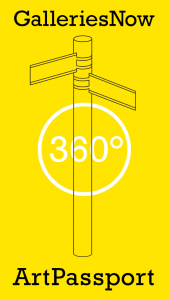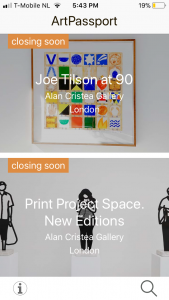ArtPassport: A Digitalized and Democratized Experience of Art
As media technologies and practices continue to advance, the art world is simultaneously facing a metamorphosis that presents new challenges to not only what constitutes art—but how art should be experienced. ArtPassport is one such example of an app that was developed in 2017 by the founders of GalleriesNow.net, brothers Tristram and Patrick Fetherstonhaugh (Galleries Now). The mission of the free app is to provide, “daily art exhibitions in 360° from the world’s leading galleries and museums” (ArtPassport). The platform provides a virtual reality experience of art exhibitions by the latest talent that can potentially remove the existing barriers of the art world and incite connections that were once impossible. To critically gauge the implications of such a technology, this blog post explores the app ArtPassport and aims to determine the extent to which digital platforms of the art world co-exist with traditional infrastructures of experiencing art and the consequent impact of this amalgamation on the art world.
Within just a year of its release, ArtPassport was ranked in the top 3 of the “Art+Experimental” category of the Webby Awards 2018, and number 8 by Time.com in their “best 25 Apps of the year” (ArtPassport). The app provides users with high resolution images and a 360-degree virtual reality experience accompanied with detailed information about the artists and their works daily—for instance, Haroon Mirza and Jake and Dinos Chapman at the 2017 Frieze art fair in London (Smith). The objective according to co-founder Tristram Fetherstonhaugh is to “demystify the art world,” continuing, “to break down the barriers that can make a gallery visit off-putting” (qtd. in Smith). This sentiment carries with it a potential threat to the way artistic content and cultural heritage is experienced; the cutting-edge technology, “lets the audience interactively operate the content, modifying and molding cultural objects in real time, in a novel, concrete, and corporeal way” (Camurri and Volpe 13). The mechanism of this technology lies in taking 360-degree photo spheres comprised of multiple images taken from a wide-angle lens of a single viewpoint which is then merged through a special interface—essentially allowing the viewer to navigate international exhibitions through their screen wherever they may be (Smith). Jin Woo and Soo Hee argue that the “proper appreciation of visual artworks in the online space” has been enabled by, “the rapid development of virtual reality and augmented reality technologies” (4). These advancements in new media through which art can be experienced drive content and service providers such as ArtPassport to design a highly interactive and immersive interface for their users (4) (see fig. 1 and 2). This digitalized experience however, threatens to disrupt the existing infrastructure of exhibiting art which will be discussed in the section below.

Fig. 1. Screenshot of the start screen of ArtPassport from; Art Passport, 21 Sep. 2018. Screenshot.

Fig. 2. Screenshot of the interface of ArtPassport from; Art Passport, 21 Sep. 2018. Screenshot.
Exhibiting Art: Infrastructures vs Platforms
Plantin et al. claim that digital technologies have made possible a ““platformization” of infrastructure and an “infrastructuralization” of platforms” which can be extended to the case of ArtPassport whereby the corporate entity which is the ‘platform’ co-exists with art galleries and exhibitions or ‘infrastructures’ in the way that art is experienced (295). ArtPassport offers a selection of both commercial and public galleries that has emerged at a time where the number of visitors to the UK’s leading museums and galleries has dramatically depleted by nearly 1.4 million in the last year—attributed by the Museums Association to “security fears over terrorism, and a possible lack of blockbuster exhibitions” (Smith). Furthermore, the founders of ArtPassport claim that the app is free to encourage the maximum exposure of artists and their works to the public wherein their platform functions as “a channel rather than an income stream” (qtd. in Westall). For these reasons the “platformization” of infrastructure can be justified as it enables art institutions to combat challenges and risks of exhibiting art including economic and socio-cultural pressures (Plantin et al. 295). ArtPassport is not the only platform that has gained success in the public sphere; Google’s Arts and Culture app and Sotheby’s Catalogue also provide a 360-degree experience of artworks. In August 2017, Facebook livestreamed a virtual exhibition of Van Gogh’s Sunflowers in collaboration with the Van Gogh Museum (Smith). Plantin et al. claim that Facebook and other corporate giants “have learned to exploit the power of platforms—which hold undeniable benefits for both users and smaller, independent application developers—to gain footholds as the modern-day equivalents” of previously existing infrastructures (306, 307). This present-day demand for access to artworks through digitalized platforms has sparked an “infrastructuralization” of platforms which directly affect the systems in place for exhibiting and experiencing art (Plantin et al.)
The Digitalized and Democratized Experience of Art
The rapid success of ArtPassport illustrates the ability for emerging digital platforms to create “new opportunities for both insiders and newcomers in the art world” (Jin Woo and Soo Hee 3). The app allows for scale and ubiquity that was not previously possible which is acknowledged by co-founder Tristram who claims that their platform draws in “literally thousands” of people, “an order of magnitude more than can make a physical visit, and that of course is what the gallery, artist and pretty much everybody really wants” (qtd. in Smith). Conversely, the argument of reaching the masses is made redundant by some who believe that the VR experience cannot replace the “real” experience of art in galleries and exhibitions (qtd. in Smith). Spatial Scientist and Architect Pragya Agarwal believes that with apps, “there is little perceptual and psychological immersion and although there is video realism, there is no social realism” (qtd. in Smith). Yet the aspect of “social realism” is not what platforms such as ArtPassport try to achieve as they strive to amalgamate with the existing infrastructures rather than replace them altogether. Digital platforms are “often making possible lower cost, more dynamic, and more competitive alternatives” to the existing infrastructures which presents a double-edged sword—expanding the reception of art at the cost of reducing the value of this reception (Plantin et al. 306). It can also be argued however, that ArtPassport is reviving the appreciation and education of art through its multimedia experience accompanied with rich information. Within the first week of its release on iTunes in May 2017, the app received 25,000 downloads and according to creative consultant Stuart Goulden, the technology offered by the app is “inviting younger and more diverse audiences into a world that might have previously seemed walled” (qtd. in Smith).
ArtPassport provides scope beyond the rediscovery and experience of art towards the sectors of education and social inclusion, dramatically shifting the infrastructural boundaries surrounding the art world. In conclusion, it is evident that ArtPassport is highly influential as an app in the digital media landscape. Moreover, it has a significant impact on ethical, economic, and socio-cultural degrees of exhibiting and experiencing art; presenting both benefits and risks to these complex evolving infrastructures.
Works Cited
“ArtPassport.” ArtPassport – from GalleriesNow, www.artpassport.com/. Accessed 18 September 2018.
Camurri, Antonio, and Gualtiero Volpe. “The Intersection of Art and Technology.” IEEE MultiMedia, vol. 23, no. 1, 1AD, pp. 10–17., doi.ieeecomputersociety.org/10.1109/MMUL.2016.13. Accessed 18 September 2018.
Frosh, Paul, and Karen Becker. “Visual Frictions.” Journal of Aesthetics and Culture, vol. 7, 2015, doi:http://dx.doi.org.proxy.uba.uva.nl:2048/10.3402/jac.v7.30655. Accessed 18 September 2018.
“International Gallery Guide & Exhibition Listings | GalleriesNow.” GalleriesNow.net, www.galleriesnow.net/. Accessed 18 September 2018.
Lee, Jinwoo, and Soo Hee Lee. “User Participation and Valuation in Digital Art Platforms: The Case of Saatchi Art.” European Journal of Marketing, Aug. 2018. ISSN: 0309-0566, doi:https://doi.org/10.1108/EJM-12-2016-0788. Accessed 18 September 2018.
Plantin, Jean-Christophe, et al. “Infrastructure Studies Meet Platform Studies in the Age of Google and Facebook.” New Media & Society, vol. 20, no. 1, Apr. 2016, pp. 293–310., doi:10.1177/1461444816661553. Accessed 18 September 2018.
Smith, Mark. “Brave New Art World: The App That Brings Galleries to Your Living Room.” The Guardian, 16 Nov. 2017, www.theguardian.com/small-business-network/2017/nov/16/brave-new-art-world-the-app-that-brings-galleries-into-your-living-room. Accessed 18 September 2018.
Tillander, Michelle. “Creativity, Technology, Art, and Pedagogical Practices.” Art Education, vol. 64, no. 1, Jan. 2011, pp. 40–46., proxy.uba.uva.nl:2048/docview/847386915?accountid=14615. Accessed 18 September 2018.
Westall, Mark. “View Art in 360º VR with the New Art Passport App.” FAD Magazine, 13 Nov. 2017, fadmagazine.com/2017/10/04/view-art-in-360o-vr-with-the-new-art-passport-app/. Accessed 18 September 2018.